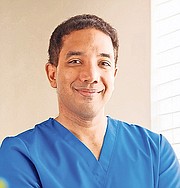By DR GREGGORY PINTO
There are many potential causes of testicular and scrotal pain and swelling.
Never let embarrassment or fear prevent you from seeking the consult of a urologist, as pain in the testicles or scrotum could be a sign of a serious health issue.
1. An unfortunate twist of fate
Testicular torsion is relatively rare, affecting 1 in 4,000 men and boys, with the vast majority of affected males between the ages of 12 to 18 years old. Cases of testicular torsion occurring after age 25 years old are far from the norm.
Testicular torsion involves the testicle twisting upon the spermatic cord to which it is attached and the blood supply being dangerously compromised.
After six hours of torsion of the testes, the viability and survival of the testes is profoundly negatively affected.
Testicular torsion is a surgical emergency.
No trauma is required and often the twisting of the testes occurs while sleeping.
The symptoms include a severe, usually persistent testicular pain that may radiate to the lower abdomen with possible nausea and vomiting.
Consult at an emergency room with immediate urologist referral is imperative to try and save the testes.
The urologist surgically detorts the testes and restores its blood supply then transfixes the affected testes and the other testes, so neither could ever twist in the future.
2. A problem of sagging
The apparent increase in the size of one or both testicles may in fact be related to an increase in the fluid surrounding and bathing the testicles. This is the case with testicular hydroceles.
The testes are surrounded by a protective lining called the tunica vaginalis, and as men get older there is sometimes an impairment in the ability of the protective tunica vaginalis covering to reabsorb fluid that is being continuously produced; with a resultant increase in the volume of fluid surrounding the testicle.
Men, particularly middle-aged or older, often have cosmetically unpleasant drooping of the testes from the increase in fluid volume of the testicular hydrocele.
The management is a minimally invasive outpatient procedure to release the accumulated fluid of the hydrocele and to evert the tunica vaginalis lining so that fluid can never accumulate again.
3. The dreaded ‘C’ word
Cancer of the testicles has various pathological subtypes and can affect men of all ages.
Men of African ancestry are affected less frequently by most testicular cancers than their other racial counterparts.
Most testicular cancers are initially painless.
Men are encouraged to take special note and inspection of their testicles regularly and seek urological consult if there is an increase in size or firmness of either testes.
Early diagnosis and treatment of most testicular cancers leads to an excellent cure rate.
4. Annoying and painful lumps
Epididymal cysts are relatively common.
They are benign but can be a source of moderate to severe pain that is often aggravated by activity.
The epididymis is a tissue appendage attached to both testicles. Men often on self-examination feel a slightly mobile pea-sized mass that is separate from the testicles in the scrotum. There is no correlation between epididymal cysts and malignancy.
5. Bowel in the scrotal sac?
A hernial defect can lead to intestinal bowel loops being present in the scrotum.
An inguinal scrotal hernia should not be ignored as the bowel loops in the scrotum could potentially be entrapped with a compromise to the blood supply to the bowel. This could lead to a surgical emergency with dead bowel.
6. A feeling of swelling
A varicocele is an engorgement of the veins of the testicles. There is often a defect in the valves of the testicular veins that helps promote return of blood from the testicles to the heart, against gravity.
Varicoceles can negatively impact sperm production and its presence must be ruled out in cases of male infertility.
Pain associated with varicoceles often worsens with exertion and increased intra-abdominal pressure.
7. You should have used a condom
Epididymal orchitis is often caused by a sexual transmitted disease.
Men complain of unilateral or bilateral painful swelling of the testicles and the tissue appendage attached to it, the epididymis.
Urinary tract infections in men can also lead to epididymal orchitis; particularly in middle age men who have recurrent urinary tract infections secondary incomplete bladder emptying caused by an obstructive prostate.
8. Scrotal pain originating elsewhere
It is called referred pain. The cause of the pain is actually not in the scrotum or testicles but it comes from elsewhere, such as the inguinal canal or abdomen.
Kidney stones, lower back nerve radiculopathic pain and infection of the prostate, prostatitis, could potentially lead to referred scrotal pain, among many other potential causes.
Examination of both testicles and scrotum by men at least once a month is a must.
Never ignore any abnormality or pain in the scrotal sac.
Confidential and compassionate urological care is readily available.
• Dr Greggory Pinto is a board certified Bahamian urologist and laparoscopic surgeon. He has trained in Germany, South Africa and France, and is a member of the European Association of Urology. He can be reached at the OakTree Medical Center, #2 Fifth Terrace and Mount Royal Avenue. Call (242) 322-1145-7. E-mail welcome@urologycarebahamas.com or visit the website www.urologycarebahamas.com.





Comments
Use the comment form below to begin a discussion about this content.
Sign in to comment
Or login with:
OpenID